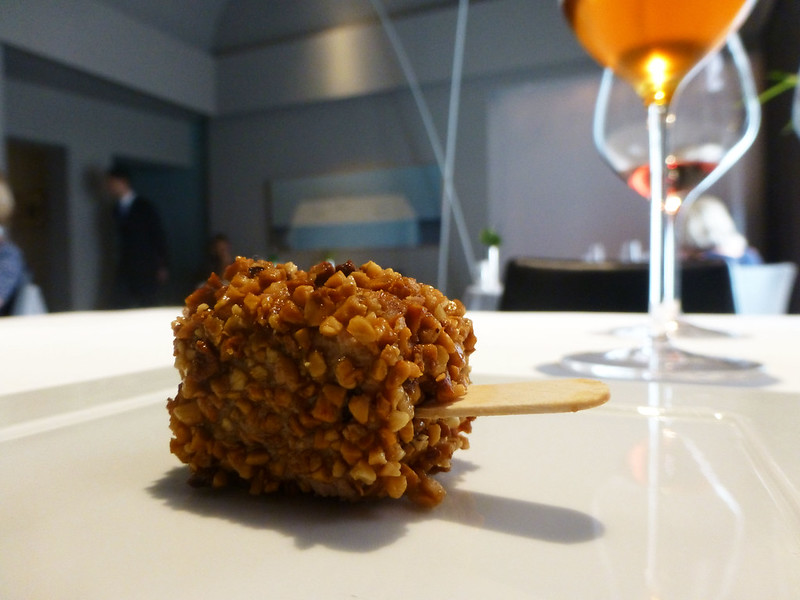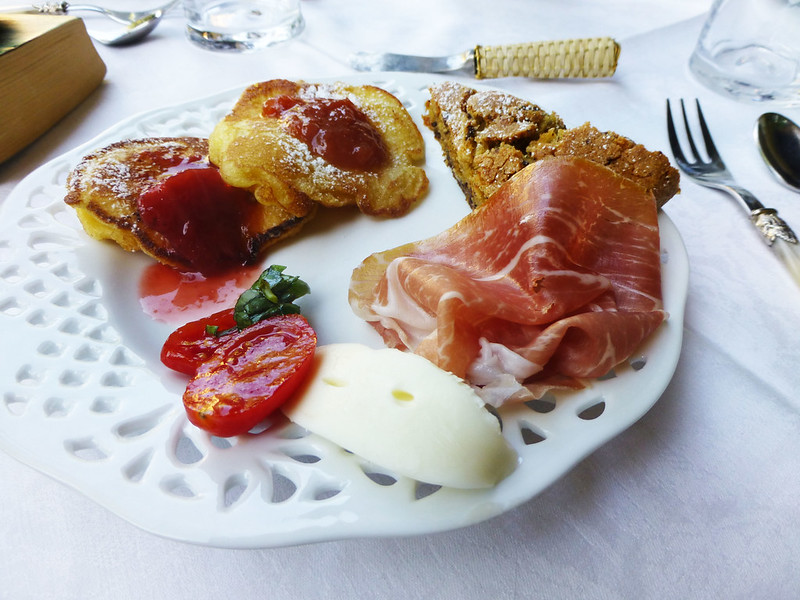A few years ago, I was lucky enough to get an interview with Chef Massimo Bottura—the man currently considered the top chef in the world—for my 100 Locals guide to Italy. I asked him what dishes first-time visitors to Italy should seek out, where foodies should travel to, and what, aside from his own, were some of his favorite Italian restaurants.
That interview first appeared aside 99 other local and expert interviews in the Italy book, and I loved Massimo’s answers so much that I immediately planned a trip down to Modena for the specific purpose of eating in his restaurant, where lunch was a glamorous, multi-hour affair filled with the strange and amazing—Parmigiano cheese served four ways, foie gras as an ice cream bar, liquor that tasted like a salad, salad that tasted like a symphony of subtle flavors.

foie gras served as an ice cream bar at Osteria Francescana
And today I’m sharing the full interview that inspired that trip here on the blog.
If you, like me, travel at least in part for the food, this one’s for you.
Now, to Massimo…
First, tell us about you and your restaurant.
My kitchen can be defined as “tradition seen from 10 miles away.” I revisit traditional recipes and ideas and make them contemporary. This is my specialty.
I try very hard to respect tradition, but also to respect ingredients and heroic farmers, butchers, and fishermen. Sometimes I have to ask if our traditions respect the ingredients and, if they don’t, then it is time to rework them. I call this “tradition in evolution.”
As a kid, I was always under the kitchen table. It was my refuge from three older brothers’ torments and threats. I found peace at my grandmother’s feet as she rolled out the dough for tortellini, among the smells of broth and roast meats and the constant chatting of my grandmother, mother, and aunt, who prepared meals for the 10 of us every lunch and dinner.
Those memories are probably why I became a chef.
When my brother told me about a trattoria on the outskirts of Modena for sale in the early 1986, I just knew that was the right thing to do. So I quit law school, bought that trattoria, and opened it a week later. I didn’t really know what I was doing, but with lots of help from my mother and a cook named Lidia Cristoni, who happened to live around the corner, I began my career.
Osteria Francescana is in the heart of Modena. It is a hundred-year-old osteria transformed into an intimate fine dining restaurant where contemporary art and contemporary Italian cuisine share the same table. In addition to the a la carte menu, we offer three tasting menus to explore our kitchen: Tradition in Evolution, Classics, and Sensations. Each has its own personality; each focuses on a different aspect of our kitchen. This makes each dining experience unique. One table can be eating tagliatelle al ragu in the Emilian traditions menu and the next a Livornese red mullet from the new “Come to Italy with Me” sensations menu. Or a revisited classic Osteria Francescana plate, “All The Tongues of the World,” which was recently featured in an art exhibition at the Beaux Arts in Paris.
What is most important to us is sharing time with our guests. Perhaps we are old fashioned in this sense, but hospitality is very important. And everyone should feel at the end of a meal that the journey was worth the trip. I often say that our biggest compliment is not the awards or the stars, but the people who travel halfway around the world to Modena, to Osteria Francescana, to have a meal with us. Nothing could make me more proud than to share my kitchen, my stories, and the unique culinary gastronomy of Italy.

A breakfast feast at Villino di Porporano in Parma
When visiting Italy for the first time, what should we try?
In the north, Piedmont and Lombardy, rice and polenta are native. In Piedmont, try the risotto with castelmagno cheese (or white truffles in season). In Lombardy, polenta concia (with cheese).
In the region of Emilia-Romagna, the handmade egg pastas are divine. In Modena, try Modenese tortellini in broth or tortelli with pumpkin. In Bologna, tagliatelle with ragu. And, near the Adriatic sea in Romagna, homemade passatelli in broth, naturally with a glass of Sangiovese wine.
Crossing the Apennines toward Tuscany, the famous ribollita vegetable soup is a must.
In Rome, seek out the best pasta carbonara and cacio pepe (Roscioli in Campo dei Fiori is our favorite restaurant for this).
East, over the Po River into Veneto, there is the tradition of baccalà mantecato (salt cod mixed with olive oil in a flavorful puree).
In Naples, there are incredible products like capers and Vesuvian tomatoes and mozzarella, so I would say pizza, but only in Naples, not the rest of Italy.
Toward the Adriatic, the seafood is so abundant, especially bluefish and baby squid which are perfect for fritto misto di pesce (mixed fried fish).
And, of course, in Sicily, pastries of any kind, especially from Caffe Sicilia, located at 125 Corso Vittorio Emanuele in Noto.
 |
Did I mention that I wrote a book full of these interviews? Get 100 interviews from top chefs, wine experts, and locals all over Italy. |
If someone is planning a food tour in Italy, what cities should they make sure to visit?
I am very spoiled living in Italy where we have so many amazing products—from capers from Panterlleria to traditional balsamic vinegar from Modena, tomatoes from Naples, fish from the Adriatic, prosciutto from Parma, and beef from Piemonte.

Prosciutto e melone
There are a group of Italian chefs who represent the future of Italian cuisine: Massimo Alajmo, Davide Scabin, Ciccio Sultano, Norbert Niederkofler, Mauro Uliassi, Moreno Cedroni, Carlo Cracco, Chicco Cerea, Antonino Cannavacciuolo, Andrea Berton, Giancarlo Perbellini, Gennaro Esposito, Niko Romito, Heinz Beck, and Giovanni Santini.
Stop at any of their restaurants, sprinkled all over Italy, and you will have an incredible experience.
In other cities, ask for advice from the fine dining establishments. The chefs in these restaurants are part of a larger community of excellence that, at times, can only be discovered by word of mouth. We do our best at Osteria Francescana to guide our guests through Modena and the area of Emilia-Romagna because there is so much to discover just steps beyond our own threshold.

Roasted vegetables with mozzarella
In addition to your own restaurant, what other restaurants do you recommend in your area or other parts of Italy?
The talented chefs I mentioned above would be my starting point. From there, I would seek out trattorias, markets, and enotecas offering a tasting of local fare.
A few more of my favorites: in Modena, there is the Franceschetta58. The atmosphere is ultra casual and the selection of Italian traditions is vast. The food is welcoming and comforting with very well-sourced ingredients. Address: Via Vignolese 58.
Trattoria Bianca, located at Via Giovanni Battista Spaccini 24, is another a local favorite, serving gnocco fritto with Emilian prosciutto, mortadella, and salami, as well as handmade pastas.
On the way to Bologna, in nearby San Giovanni in Persiceto, there is the rustic Osteria Mirasole. Franco grills excellent cuts of Italian Piemontese beef on a grill in the restaurant. His selection of reds pairs perfectly with the food. Address: Via Giacomo Matteotti 17.
In Imola, just past Bologna on the way to the Adriatic, there is a beautiful restaurant called San Domenico with wonderful Italian traditional plates. Address: Via Gaspare Sacchi nr.1.
On the Tuscan seaside, in the medieval city of Pietrasanta, I love Enoteca Marcucci where fine wine accompanies a simple meal in a unique setting. Address: Via Garibaldi 40.
In Rome, I can be found at Roscioli in Campo dei Fiori (at Via dei Giubbonari 21) for a quick snack or a plate of carbonara, or at EATaly (www.eataly.com) for my grocery shopping.
In Noto, Sicily, I am always at Caffe Sicilia (at Corso Vittorio Emanuele III 125) for the pastries and granita created by Corrado Assenza.
In Venice, you’ll find me at Caffe Quadri (at Via Liguria 1) run by the Alajmo brothers (who also run Le Calandre in Padova).
Love this interview?
You can find Chef Massimo at Osteria Francescana and you can get 99 more local expert interviews in Italy: 100 Locals Tell You Where to Go, What to Eat, & How to Fit In.
